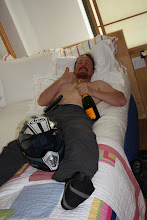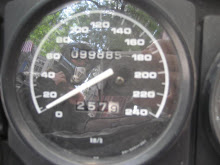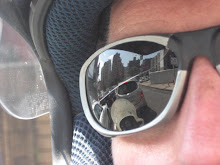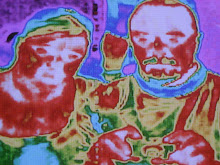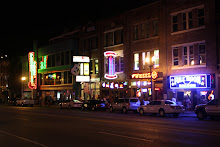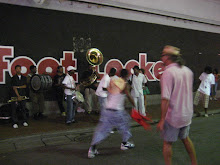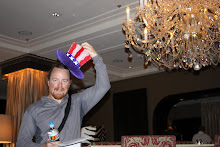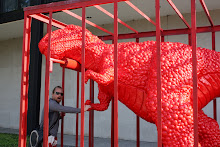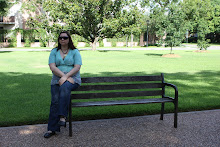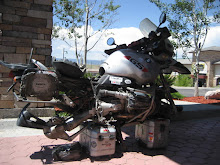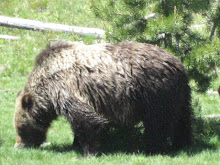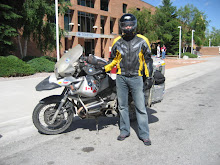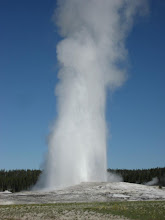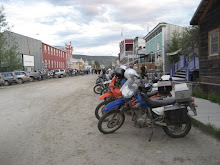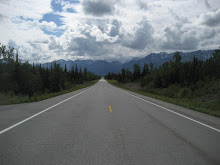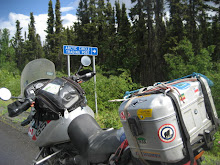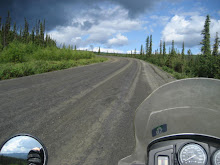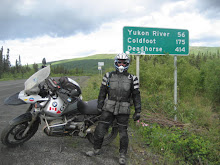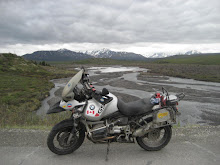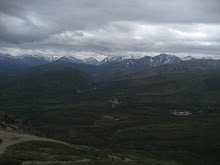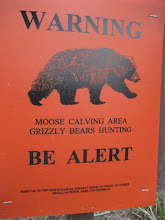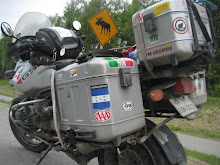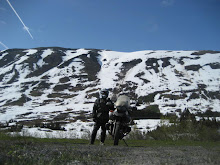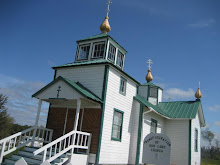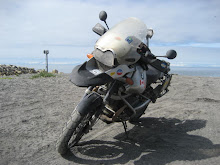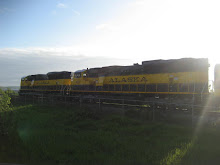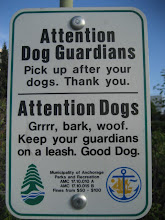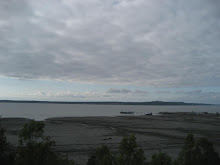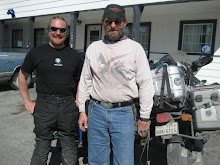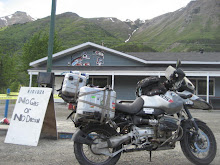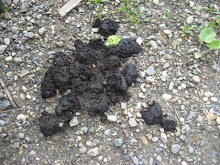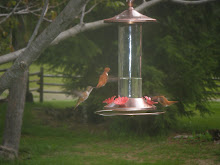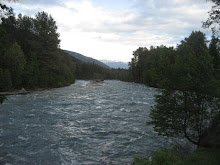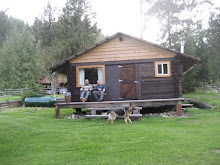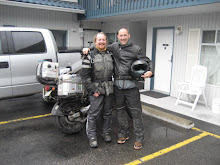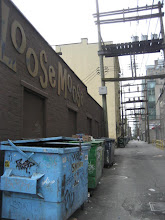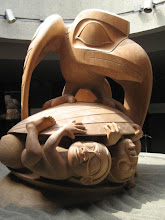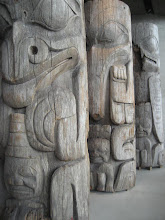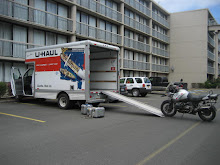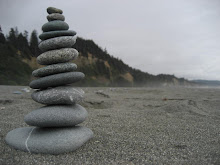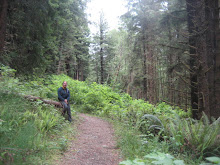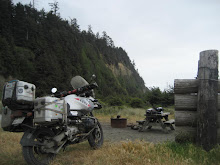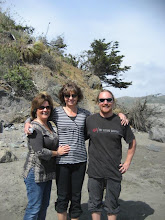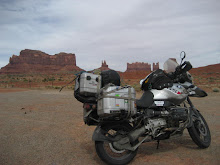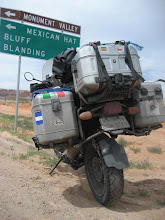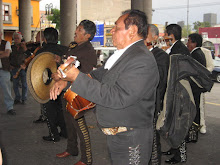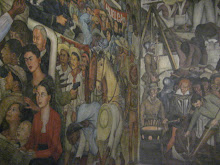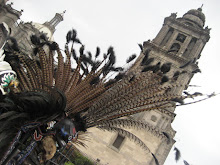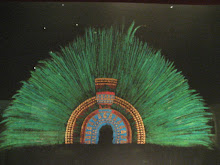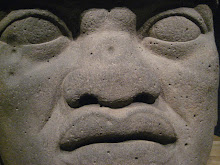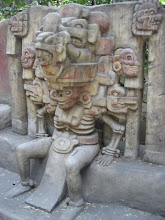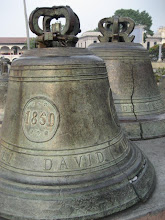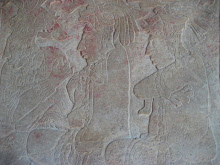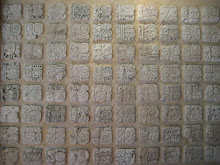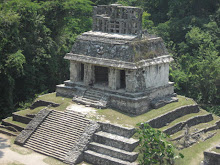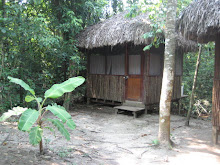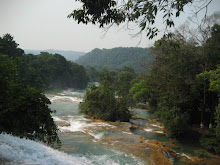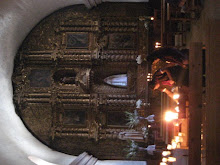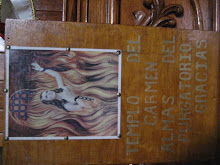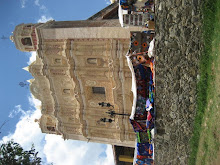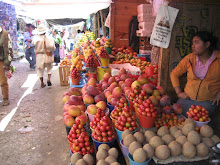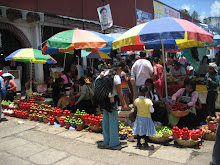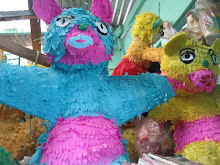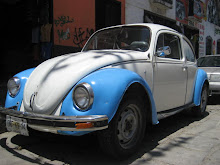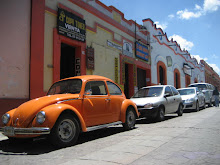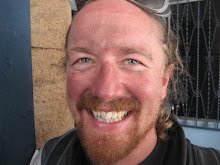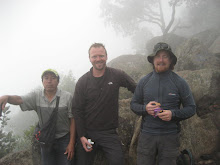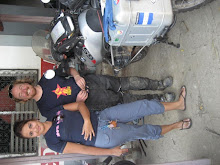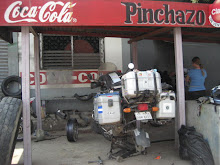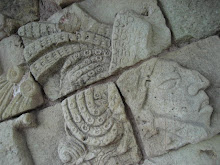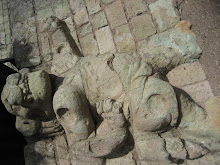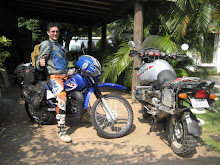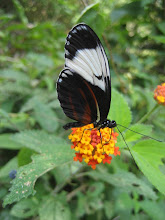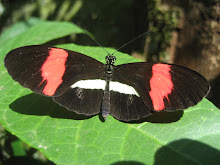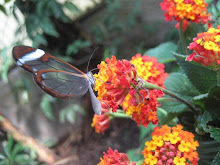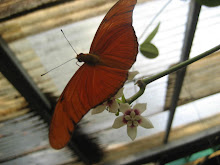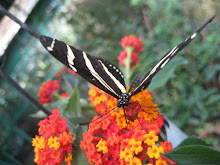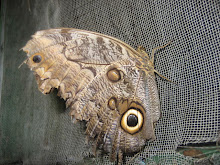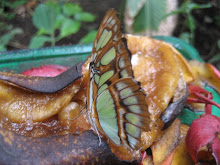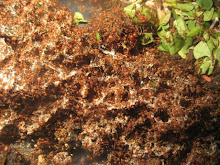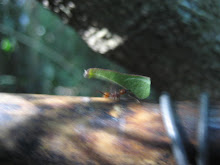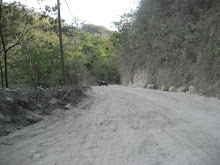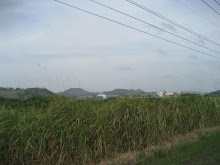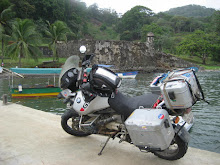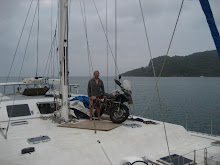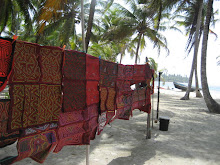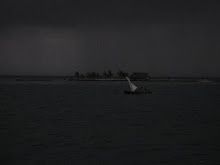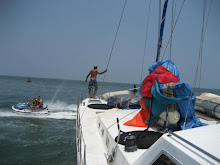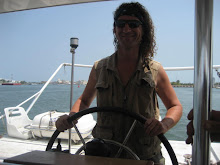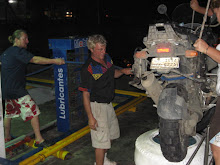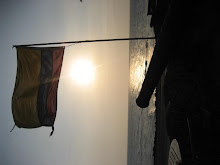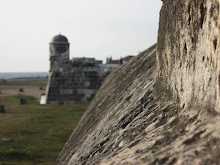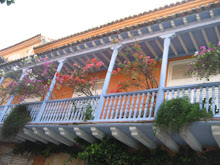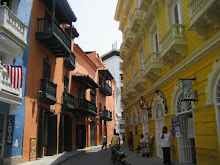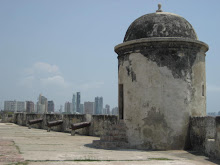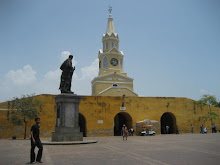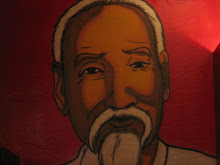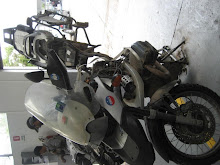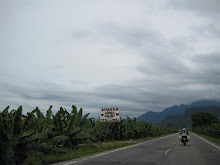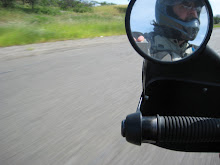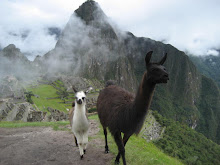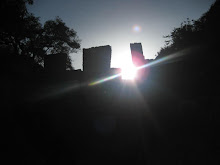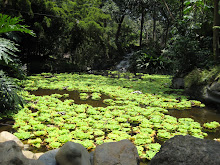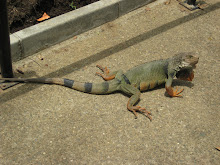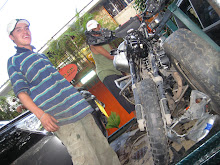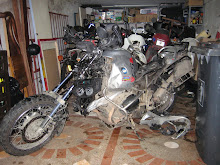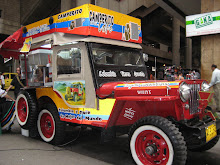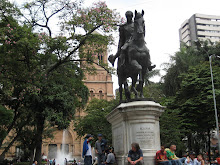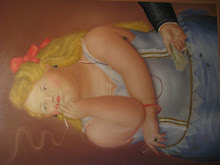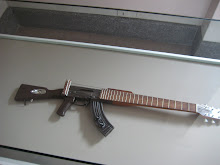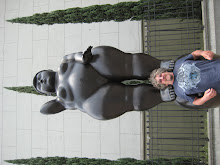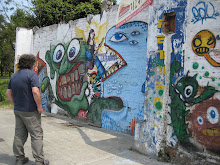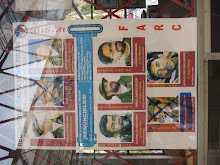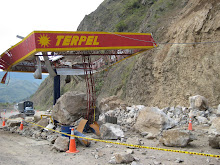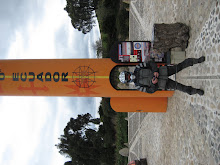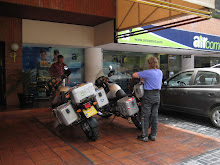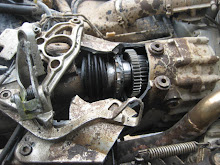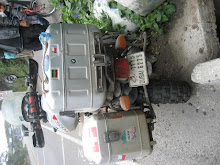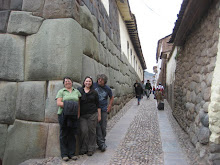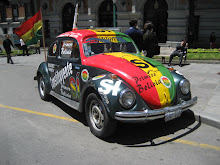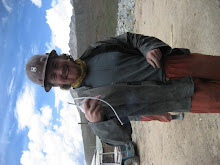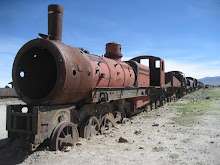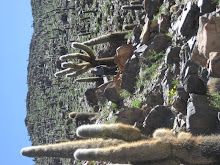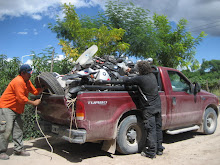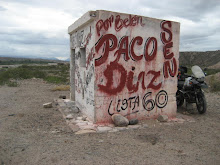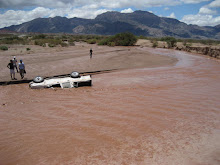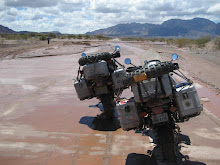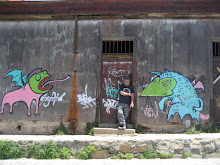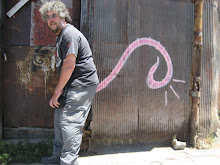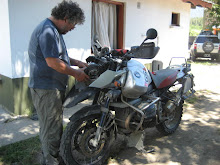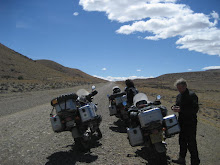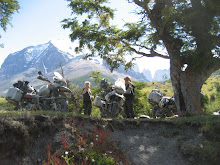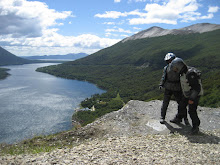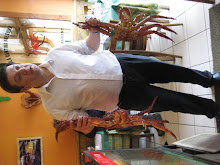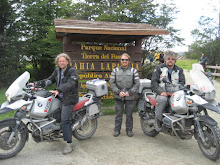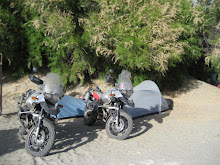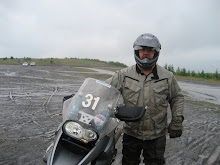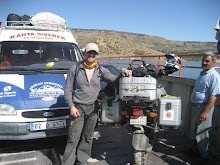On the way to Palenque we stopped off on the twisty, mountainous road to go swimming in Cascadas Agua Azul. It was delicious to get out of sweaty hot bike gear, exposing our sweaty, spongy flesh to the refreshing water and the gentle sun, filtered through the leaves and humidity of the jungle. Whilst twisty in sections, this was also The Road of Topes / Tumelos, (sleeping policemen), most of them locally made by those Chiapans living nearby. It was frustrating to have to keep slowing down, for no apparent reason in the middle of nowhere and with no signs or warnings. There were some signs saying you are now entering Zapatista Chiapas, Viva la Revolucion, etc, most probably left over from the period of several weeks a decade ago when the region claimed and effectively achieved independence under the balaclava - clad SubCommandante Marcos.
The road improved in the end, although increasingly surrounded by the electric hum of cicadas and the humidity of the jungle as it closed in on us as we descended towards the Caribbean. Onto the gates of Palenque National Park, avoiding the surprisingly large town, and we stayed in the Jungle Palace. It was a lovely setting as we parked amongst the trees and I got settled into a quiet isolated corner, next to the stream and recovered from the biggest bead - on since Bandar - e - Abbas in the gauze cube that would be my home for the next 2 nights. A combination of too much Bohemia and the noise of the jungle at night outside and scuttling and scurrying across the concrete floor of the hut, meant I was up before dawn. Listening to the ringing, chirping, buzzing, sawing, wailing and knocking of the early morning jungle noise, I decided to get up and walked and talked on the phone to my Mum and my brother and got ready to explore the ruins with Hamish and Emma, our last day together. They too had a bad night due to noisy neighbours and so we went back to sleep and went to the ruins in the heat of the day, when all the coaches had left. We had a great day, tramping over the impressive Mayan site and soaking in the relaxing, if hot and sweaty atmosphere together.
Hamish and Emma are a great couple who shared a lot in common with Lena and I. Hamish and I got on very well as he was always keen for a cool beer and Emma was a unique person too, always having an interesting perspective on things. For instance, she was wearing a balaclava under her helmet in the Mayan jungle, Commandante Marcos style, and when I first met her in Medellin, she offered me some delicious sprouting beans that she was growing in a plastic pot in her pocket - all whilst on a motorcycle adventure trip through Latin America. They were Ex Pats, having lived in Malaysia and both enjoyed writing; we could share stories about some of the places we had travelled to and people we had met (on this trip and before) and motorbikes of course. Still by the end of our time together at Palenque I am ready to get going by myself again. I am confident we all had a great time together in Central America and Southern Mexico, which is pretty remarkable really given we were initially strangers having only met briefly in Medellin beforehand. I sensed in myself over the last few days, a feeling which I believed was reciprocated by Hamish and Emma, that we were all anxious to resume our trips at our own pace, without the added logistical difficulties and inevitable individual compromises that travelling in a group, even a small one entails. They have become firm friends and I will definitely keep in touch with them and hope to meet up with them in the UK over the summer when we are all back and hopefully beyond that too.
Palenque was remarkable for its setting amidst the jungle, throbbing with life, like the skittish lizards with a fin fan thingy across their heads and the striped toucans, both of which would thrash through the vegetation on your arrival into a quiet glade on the heavily wooded northern sections of the ruins. Also, the similarities with ancient Asian, particularly Chinese, archeological sites was striking to me. The prolific use of cinnabar red and jade green, the creation of jade death masks and the employment of terraced pavilions along with the almond eyes of the Mayan figures depicted in the statues and friezes. The whole site was on a grander scale than Copan and the musuem highlighted some interesting exhibits and facts, like the fact that Venus was the God of War for the Mayans. This, and a lot of other interesting facts, were all revealed because the Mayans, unlike the Incas of Peru, did have a glyphic writing system, which phonetically still sounds like the present day local dialect - Chotl. More remarkably still however, is that they could build on such scale and with such artistic detail with no metal tools, no wheel and no beasts of burden, just like the Incas.
After tramping around the jungle and getting back for a shower, I met Loiusana Steve and his dog, Pachunki, which was Chotl for stone. He invited me up to his place for a coffee. He was an interesting character who had retired from the US Navy twenty years ago and ended up in Mexico because of the cheaper cost of medical care than in the US. He was a cyclist and biker and we talked about routes, etc for a while, whilst Fox News played loudly from his home theatre system, oddly wrapped in plastic bin bags to protect it from the humidity of the jungle. It gradually became clearer to me that he had also left the US because he was a very right wing person politically, and was dissatisfied with the "liberal track the country had taken recently"! This included examples of how Taser parties were becoming more popular, according to Fox News. These electric shock guns are completely unregulated in the US, and apparently, those "liberals" who feel uncomfortable openly owning a gun, are increasingly attending parties run along the lines of Ann Summers or Tupperware parties, trying out the product and choosing various fashionable covers, like mobile phone covers, and holsters before making their purchase. Good ol' boy Steve, just couldn't understand why they didn't just buy a regular automatic weapon for godsakes!? I made my excuses and left. It was a shame that his bigotry had made me rush off as Pachunki was a great dog.
The Howler Monkeys were about again during the darkness of the pre-dawn, and after a charming dawn breakfast with Hamish and Emma, I got on the bike to go and realise they had been using my bike as high - altitude target practice, crapping on bike from above. Charming! Again, another dubious guidebook statistic says that they are the largest primate in the Western Hemisphere. They may actually be bigger than the Mayans in their local area, but they are certainly not bigger than the larger North American branch of the dominant Homo Sapiens Sapiens simian species. I realised during this period that I am developing a loner mentality and significantly start singing "One Man Guy" by Loudon Wainwright III to myself in my helmet - studio as I leave the jungle fastness of the Mayan kingdom for the mountains of Oaxaca and the Zacotec federation. First I have to sweep down close to the Caribbean between Villahermosa and Minantitlan. It was officially 38 degrees today and I use one of the stops at the expensive pay booths for the toll roads and put sun screen on but it was soon so hot again that it ran into my eyes, making my vision blurred. Just like the Howler Monkeys at dawn earlier that day, you could smell Mexico City before you could see it. Tired and with sore eyes from the baking heat and sun screen an daunted by the prospect of entering the heart of the largest city in the Americas on Friday rush hour, I stop in the nearby suburb city of Cordoba for the night.
Checking in at a hostal on the main square, I feel half deaf as well as half blind as I can barely understand the speed and accent of the lady who owns the place and is trying to direct me to the garage door at the back. There is definitely a faster, sing song and nasal Spanish in Mexico than I have been used to and it seems to be getting faster as I get closer to Mexico City. I take a stroll in the early evening and check out the old cathedral bells in the square from the old church that fell down, yep you guessed it, from an earthquake in the nineteenth century.
Mexico City is a great American City (certainly THE greatest American City in terms of its sheer size) and suffers from all the glories and shames of all its lesser cousins to the north and south. Poverty, crime, great architecture and food etc. Riding through the hillside townships, before descending into the smoggy valley of Tenochtitlan. This is where the legend of Quetzalcoatl is linked with the founding of the city, when an Aztec ancestor saw an eagle swoop down and take a snake hanging from a cactus to cool down. The sight of the eagle flying away with its prize, looked like the legendary plumed serpent and that was seen as a good omen, leading the Aztecs to found the city of Tenochtitlan on the site and the post - independence Empire of Mexico to use the symbol as its new bandera nacional. I soon got lost, but knew I wasn't far from the centre, so I hired a Vocho taxi (the unregistered green and white V Dub taxis of Mexico City), driven by the friendly Vochero, Diego, to lead me to the Zocalo, the heart of historic Mexico City and Tenochtitlan before it. The Spanish built the current Cathedral over the Templo Mayor of Tenochtitlan, (apparently an enormous pyramid, possibly the biggest in the world ever built, with twin temples to the Sun and the Moon built on top) which in the same unmentioned guidebook, is listed as both the oldest and largest in Latin America, first built in 1525 and added to in several waves of construction since. The bell towers lean at alarming angles, as do a lot of older buildings in the city, due to seismic activity and make a great scene on the Zocalo, along with the Palacio Nacional and an enormous bandera nacional, which was only marred by a lot of construction work in the centre of the world's second biggest public square.
Mexico City has Museums and Avenues to rival Paris and St Petersburg, monuments and history to rival London and Berlin, food and drink to rival Bangkok or Sydney and public art to rival Barcelona. For instance, there were hundreds of fantastical Leonora Carrington paintings displayed all along the Paseo Reforma approaching the jewel in the crown of Latin American Museums. The Museo Nacional de Anthropologia houses an enormous collection of material (statues, weapons, artifacts and whole buildings) from the whole range of pre - Cortes Mexican cultures. Massive Olmec heads, an enormous statue of the God of Water and loads of models of quetzalcoatl looking like a chinese dragon in many of its representations across millenia of the various Mexican civilisations. I learn that in Chihuahua they used to breed the dogs of the same name for food and that Tenochtitlan was preceeded by the older city of Teotihuacan, which lies 40kms to the north and still incorporates the pyramid of the sun, second only in size to the Great Pyramid of Cheops in Giza. The area around the museum, the Bosque de Chapultec, is also full of interesting monuments and Mexicanos relaxing in the biggest green space in a generally very dirty and polluted city. There are some odd staturary bedfellows of the twentieth century outside - Churchill, Gandhi and Tito are all in close proximity, great personalities who couldn't stand each other in real life and yet face each other in heroic poses for posterity.
However, the city also has a chaotic and unfinished feel about it too. The Monumento de Revolucion started life as the new portal to the National Assembly formed after the revolution of 1910 but the political situation changed and the assembly was never finished, with a much smaller cabinet meeting in a small room behind the Palacio Nacional instead. Here is another great example of chaotic Mexican political history. Diego Rivero painted a mural to depict the entire history of Mexico from Cortes' capture of Tenochtitlan to the modern period, with Iturbide, the Basque dictator who ruled Mexico for the first 2 years after Independence, the imported Habsburg Emperor Maximilian, the bandido turned revolutionary leader, Pancho Villa and even his wife and iconic artist, Frida Kahlo are all depicted in a compelling swirling scrum of a riot, which in my view pulls off the audacious objective set by the artist. Other murals depict the major pre - Cortes civilisations including the Mexica (Aztec), Mayan and the earlier Olmec and Toltec.
Just to give you some idea just what an audacious visual extravaganza Rivera's murals at the Palacio Nacional are, here is a potted history of just less than one of the five centuries of Mexican History that I picked up from my visit. In 1821, after the revolution in Spain, the Empire of Mexico (it then included all of Central America, apart from Panama which was part of Colombia and most of what is now the western United States) declared Independence under Augustin de Iturbide, the Basque General. He lasted for 2 years before a federal republic was formed, with an uneasy balance between radical and conservative forces. General Santa Ana established military control after a brief civil war and managed to lose the province of Texas, who had rebelled against the Mexican abolition of slavery in 1829, later to be annexed by the USA in 1845. Mexico obviously didn't like that, so they marched onto the Alamo (which they eventually took), were later repelled and the US occupied Mexico City in 1847. In the treaty that followed, Mexico lost slightly more than half its total terrority to the USA, from Texas to California and from the Rio Grande to Oregon. Popularist Benito Juarez then started to implement liberal reforms, contested by the conservatives and the catholic church in another civil war and when he tried to nationalise the oil industry, the Spanish, French and British invaded to protect their interests. The French stayed to occupy Mexico City and Juarez withdrew to fight a guerilla war, whilst the French installed Maximillian Habsburg as a puppet Emperor. He managed to force the French to leave with the help of his Prussian cousin's growing influence in Europe, but was captured and shot in 1867 by the guerillas of Juarez, who returned as President and unusually died of natural causes in 1872. General Porfirio Diaz took control after a period of initial unrest, until 1910, when a new revolution occured. which amongst others involved Pancho Villa, who raised an army in the north from his network of bandidos and successfully marched on Mexico City. Phew! See what I mean!?
One evening I went to see the Mariachi bands touting for business at the Plaza de Garibaldi (which was actually a bit sad) and stopped for a beer at the Salon de Sol, which is not a tanning studio, but a bar sponsored by Sol Cerveza and sells cheap snacks, normally frequented by locals. Fortunately they also serve more palatable Mexican beers, like Negra Modelo, Bohemia and Dos Equis Amber. There was a football match on between Club America of Mexico City and Chivas of Guadalara. The most amusing thing of the whole scene for me, apart from enjoying the cool beer and the tacos caliente, was the replica shirt worn by the fans. One group of Club America supporters who I got chatting to, a "gang" who called themselves Lopez's Lobos, were full of macho posturing, overflowing with beery fizz and testosterone and yet they were proud to wear "Bimbo" emblazoned across their chests, the brand name of the Mexican brand of spongy white Mother's Shame bread and sponsor of their team.
Mexico has very expensive toll roads (which I used sometimes as they stop me getting lost) however, oddly the deserted roads in the middle of nowhere are the most expensive and the city sections are the least expensive or free!? That is before you count in the cost of propinas for the local filth. The six - lane Highway 57 out of Mexico DF towards Queretaro, despite being horrendously busy is also off limits for motorbikes. Another strange example of Mexican traffic regulations, trucks and motorcycles have to constantly use the feeder roads that run parallel to the highway between each junction. They are old, two lane highways, badly surfaced, punctuated by traffic lights and glorietas and horrendously congested. Unfortunately I became familiar with them in great detail after being pulled over by Officer Gomez from the main highway, oblivious to the restrictions. Clearly I had broken the law, he was able to point to a tiny sign on the road, but the apparent on the spot fine of 1,600 pesos seemed well over the top, so I decided to go into my well practiced routine of acting stupid and refusing to pay. However, Gomez was a professional, and by this time the tow - truck (to commandeer my bike) and 3 of his mates in uniform have arrived, playing the good cop, bad cop routine to a tee and it becomes clear that neither I or my bike are getting out of there until I hand over some pesos. I manage to get it down to 250 pesos and get off sharpish, or as sharpish as possible on the clogged service road that trucks and bikes have to use, relieved to be on my way and that they didn't ask me for my non - existent insurance.
Into Zacatecas during stormy weather and into the town that feels more Spanish than Spain. It was founded in 1548 when the country was known as New Spain, although most of the archetecture is not very new and the town has avoided the sort of cheap development that has scarred Spain in the 1960's and 1970's, as well as during the last property boom there. Unfortunately, not only was I soaking and cold at over 2500 metres of altitude, but there was hardly a room left in the town due to a festival, I had to go for an expensive as the only place available with safe parking for the bike. This is always a priority, but with the streets thronging with people and firecrackers and rocket going off, it was even more important during the fiesta. The Hotel Quinta Real is built into the side of a bullring, with an aqueduct soaring over the circular arena, both of which were built of the local rose stone and in the sixteenth century, I soon fell asleep, tired from the ride and the lack of sleep in the noisy hotel in Mexico DF. Next day I looked around the city at the elegant cathedral and then walked around the Mina de Eden and took the telepherique up to the Cerro de Bufa, to overlook the town. For obviuos reasons, it reminded me a lot of Potosi in Bolivia, as geologically they were both similar, previously relying on their silver deposits but now mining the pockets of tourists. However, the difference between the richest and the poorest country in Latin America was stark. The closer I was getting to the US border, the bigger and newer were the trucks nd it was clear that a lot of money has been spent in Zacatecas to clean up the monuments and make this a comfartable place for visitors from north of the border.
On the way to the Copper Canyon I stopped in Delicias, just outside for petrol and was tempted by the trucker's cafe, La Posta de la Viajeros and their comida corrida. It consisted of caldo, arroz, guisado del dia (chiles rellenos) y frijoles refritos all for 45 pesos, or about 22 pence. I eventually arrive in Creel in the dark and wet soaked to the bone and hoping the weather improved tomorrow. I stayed at the small but friendly Parador la Montana, but didn't have a good night as my bike had to stay outside on the street and I kept waking up to check it was OK. Next morning the weather wasn't any better, some of the trails were closed due to flooding and the views were obscured by the clouds, rain and mist blown over the multicoloured cliffs and peaks by the strong cold winds. Most of the men here wear sombreros y botes de vaqueros and I entertain myself with Clint Eastwood fantasies every time I walk into a place here. I keep execting someone to sidle up to me and say "you ain't from these parts are you?" as seems to happen in all his Westerns - Outlaw Josey Wales, Pale Rider, High Plains Drifter, Unforgiven, etc. It is certainly wild and it is western here. Less than 100 years ago that Pancho Villa was causing trouble hereabouts as a bandido. But because he was only doing that mai9nly with Gringos and then shifted careers to become the Northern General in the forces of the Revolution, he is a local hero.
Just last week on the MSN website I was morbidly interested to see this report which wouldn't be out of place in a Wild West tale from 150 years ago ...
"Assassins gunned down a senior police official in the border city of Ciudad Juarez early Saturday as Mexico's gangsters pressed their counteroffensive against the country's security forces.
Municipal Police Chief Juan Antonio Roman was shot about 2 a.m. in front of his house on the outskirts of the city, which is across the Rio Grande from El Paso.
Another of Roman's police commanders was shot shortly before he was killed.
Roman's was one of more than 100 deaths, including those of at least 20 police officers, attributed to organized crime last week across Mexico. Among those killed were a top commander of the Federal Preventative Police, whose gray-uniformed agents have spearheaded a crackdown on the criminal underworld.
Gangland violence has been sweeping Mexico as powerful narcotics smuggling gangs battle one another for dominance. At stake are the lucrative smuggling routes through the country to transport cocaine, marijuana and other narcotics to U.S. consumers.
President Felipe Calderon launched an offensive against the gangsters upon taking office in December 2006, dispatching some 30,000 troops and federal police to the most violence-plagued communities.
While failing to seriously curtail narcotics traffic, the offensive has weakened some criminal organizations, enhancing bloody internal rivalries. By some media counts, more than 3,000 people have died in the past 17 months, including scores of police officers and soldiers.
Violence against police was rare until recently in Mexico, as gangsters preferred to use silver instead of lead to persuade officials to leave them alone. But amid Calderon's offensive, the gangs have started hitting at the local, state and federal police.
"It's a war between the cartels and against the state," said Victor Clark, a human rights activist in Tijuana. "The government action has dealt a blow to the interests of organized crime, And they're fighting back."
Roman's name headed a list of "executable" city police officers that was publicly posted by gangsters in January.
Standing in the street in front of his house, with his wife and three children inside, Roman managed to shoot back at his killers but was cut down in a volley of more than 60 bullets, said Jaime Torres, a Ciudad Juarez police spokesman.
"He was able to repel the attack, but he was outnumbered," Torres said. "It's a very sad day."
Calderon called Friday for his nation to unite against the gangs. But years of endemic police corruption and abuses have left many Mexicans cynical.
Mexican officials have acknowledged that some officers — especially local and state forces — have been killed for their role in protecting one criminal gang or another rather than in the line of duty.
"They haven't been able to break the ties between the organized criminals, police and political power," said Clark, noting that 144 municipal and state police officers were fired in Baja California last week.
The federal police commander killed Thursday, Edgar Millan, was met by assassins as he arrived home in Mexico City. Investigators suspect they were helped by someone from within the federal police."
I decided to head out of town and head to the border, concerned about the weather and my soon to expire documentation. There were however lots of Road Runners in evidence on the roads, which even though they weren't as colourful as their Warner Bros cousin and the only coyotes visible were roadkill on the edge of the carriageway, they were nonetheless entertaining on the long straight roads. The mountains of the Sierra San Catalina look sombre, with their cap of dark grey ominous clouds like a sombrero pulled low over their face against the sharp winds and lashing rain. Racing the storms along the geometrically precise desert roads. A vast muddy inland sea had opened up to the valley to my east as I headed north that wasn't marked on my map. I stopped off at a flooded truck stop in Villa Ahumada for a warming coffee. The AC was on full blast despite the unseasonable cold weather and so I headed back out across the High Chapparal towards Ciudad Juarez without a sign of Lorne Greene and his family anywhere. By the time I got to Villa Ahumada the town itself was flooded, with only the elevated railway with its triple decker carriages soaring above in the dry, and so that was the route I took out of town. Beforehand, I stopped to have a coffee to warm up and to get insurance, which was advertised along the way, but none available here for motorbikes, hopefully in Ciudad Juarez.
I see that my bike has got caked in mud and dirt. Mud has its uses though - at least I will be able to tell whether the oily patch on my engine covers was from the previous petrol leak I noticed when leaving Chiapas or a more worrying oil leak. Heading into Ciudad Juarez, I start to see the biggest concentration yet of all the maquilladora factories and the resultant truck traffic. I quickly find myself at the border bridge (without insurance) and head into the customs area. My bike and luggage is checked thoroughly and I have to queue for a long time to get my passport stamped. However, somewhat strangely, despite my prompting, no - one is interested in my motorbike title documents and so I ride off into the city of El Paso as it is starting to get dark by this stage. I quickly come to the conclusion that there are a lot of crazy people in El Paso. On the way for a celebratory beer, I went to the Tap in the downtown area, there were lots of people talking and shouting to themselves in the streets. Only later did I realise that they were using bluetooth handsets, something which is still not common in Latin America. I really mIssed Neil as we could have cleaned up at pool due to the mediocre standard on display at the table in the back. I also met Crazy John, who "befriended" me at the bar. He said he worked for the "JD" (Justice Department" as a secret agent / hired gun assassin who had travelled all over the world. I think he wanted to make sure that I knew he had been to more places than me! Anyway, I made my excuses, having to resort to being rude, safe in the knowledge that most secret agents don't tell strangers in a bar that they are secret agents.....
Leaving the city the next day, I really noticed the enormous trucks and cars where no - one has the window open, even though the weather was hot. The result of this is you can't ask questions of car - drivers as you are in traffic and the big cars seemed like a barrier between them and the outside world generally and me in particular. El Paso was full of offices and signs for bail bond agencies, EZ loans, pawn shops and one dollar shops. There was not a newspaper stand or bookshop in sight. Both observations made me happy to be on my way north. However, I had read that El Paso was a key point on the El Camino Real de Tierra Adentro. In 1598, a wealthy nobleman from Zacatecas, Don Juan de Onate, set out with a party of 500 to claim the northern lands for King Philip II. It took him 4 months to cross the Rio Grande at El Paso (it had just taken me 2 days to do the same trip) and he celebrated with a mass and the first thanksgiving ceremony in North America, jointly with the local Manso Indians, 23 years before the more famous Pilgrim's ceremony in Massachusetts. He extended the Camino Real for 1,500 miles from Mexico City to Santa Fe.
I followed the route of the El Camino Real de Tierra Aldentro, heading north out of Texas and through New Mexico and less poetically now known as Interstate Highway 25, to Albequerque and then west on Highway 40. Getting tired and wet from more showers I stopped and stayed for an unremarkable evening in Sky City Casino on Interstate 40. Tired, mainly because psychologically, the conversion to miles from the now familiar kilometres means that it is taking me surprisingly longer to get to places marked on the signposts. Up early the next day and onto Monument Valley, which is not a national park, just a section of Highway 163, which quickly crosses from New Mexico to Utah and then into Arizona. I really enjoyed the ride amongst the familiar vista and surprisingly, with the addition of some curves too, it was an all over nice ride. There were plenty of other bikes too and I got talking to Brad and Lindi at a fuel stop at a "trading post" who I had passed yesterday on Interstate 40. They had a Harley Night Train with a trailer and were on a 2 week tour of the West from their home in Oklahoma.
Monday, May 26, 2008
Wednesday, May 7, 2008
Into North America
After crossing the hot and hassly border crossing from Costa Rica, I was soon into the noticeably more arid landscape of Nicaragua, zooming past the beautiful Lago de Ometepe, with its stunning twin volcanoes providing a scene of unparalleled visual harmony to my right for the first 100kms. It really felt for the first time since northern Argentina that I had at last, overtaken the rainy season, which had been advancing north with me. The countryside was dessicated and shades of dun brown, clearly not having seen rain for many months. I was soon into the outskirts of Managua and heading towards the suburb of Asosoca, nestled under yet another volcano (of which there are more in Nicaragua than there are pubs in Britain). I pulled up at Salvador's place and was greeted by him and Hamish and Emma. After having a shower to get the dust and sweat of the road of my skin, we soon settled down to and evening chatting and drinking in his lovely garden. We filled a large bucket with empty cerveza Victoria cans.
The next morning was spent nursing hangovers and taking longer than planned to start our respective motorcycle journeys. Emma and Hamish got off in the heat of the day to visit a friend in Esteli, before continuing north into Honduras. Salvador decided not to leave that day for his ground - breaking tour of Nicaragua on one of his Yamaha DT 175's. His organisation, Salcar, aims to raise awareness of health issues in the remoter parts of Nicaragua as well as increase access to healthcare by using small off - road bikes to get supplies to places with no other medical support. His trip was aiming to do this, on a route with no fixed roads, to publicise his work and find new locations that needed help, as well as establish a new touring route for his bike hire company, which he used to support his charitable work. I went out in the heat of the midday sun to see a bit of Managua and to get my sidestand repaired, with Salvador's friend, Ramon, kindly offering to be my guide.
Heading through some of the poorer areas of Managua to find the Soldador, I quickly remembered reading that Nicaragua is one of the poorest countries in Latin America. Having been a victim of more than its fair share of natural disasters and an equally tumultuous history, the Nicaraguans I met were friendly and gentle. They reminded me a lot of some of the Indians I have met in Dubai and India, gentle and unassuming, accepting and getting on with things, despite their difficult lives. Ramon was a case in point. Gently spoken, he came back to see me the next day to give me a keyring he had bought, with a fob of my name carved from wood which also said "receurdo mi tierra" on the back. We found the Soldador's house and I manouevered my bike over some steps and into his garden. I paid Trenta Cordobas (just over 2 quid) to get my dicky sidestand sorted. The welder, cut the stand through the middle, bent it to the right angle and then welded it all back together, whilst I, Ramon and his family watched, quaffing cold and refreshing coca cola that I had bought from the almacen opposite in the stifling humidity.
Well pleased with the repair, we went on into town, stopping off at the Catedral Viejo. Like the city centre that surrounded it, the building was oddly decrepid and eerily empty, despite its position on the main square. It was devastated by the 1972 Earthquake and had remained desolate ever since, with a clock in one of the pair of towers that remained as part of its facade, recording the time of the seismic dislocation at ten past three. Then we rode up to the Lemas de Tiscapa, a volcanic hilltop with a crater lake, great views over Lago Managua, a refreshing breeze and the monument to Sandino, the General who fought a relentless guerilla war to end the occupation of his country by US Marines from 1912 until 1933. Before they left, the Marines trained the Nicaraguan National Guard, commanded by the first Somoza, who promptly assasinated Sandino in 1934, until he was himself assasinated by Ruben Darien,a demented poet in 1956. Somoza's two sons then took it in turn to occupy the presidency, with US support, until the Sandinista Revolution of 1979.
After this brief insight into the turbulent geological and political history of Nicaragua from atop the Lemas de Tiscapa we rode on to the bizarre Huellas de Acaulisca. This "musuem" consists of a series of footprints from 4,000 BC, of twenty people walking across the muddy shore of Lago Managua, and then having the footprints entombed in volcanic ash. Returning to Salvador's via the supermercado, I cooked dinner and we had a quieter evening, joined by Yasuki, a gentle Japanese cyclist who was heading south from Vancouver. He had worked there in a shop for a few months to practice his English and earn money to finance his trip. He told us that the day before he was due to leave, he went back to the shop to say goodbye to everybody and his bike was stolen from outside. He obviously had a strong character inside his mall frame and gentle personality, as he had worked for a few months more to earn enough to buy a second bike and had consequently travelled through North America through the harsh winter. He was a really nice guy and I was happy to be able to give him my maps of South America to help him on his way.
The next day, Yasuki was off early and Salvador was fresher to be able to start his trip. His departure was delayed still further when he realised that Yasuki had left with a set of his house keys in his pocket, so I chased after him and retrieved them from him. After taking some photos of Salvador as he left, I went on a lovely ride, without my luggage through Managua, across to Masaya, with its interesting market and impressive volcano, which you could ride right to the top of. Then I went to Granada, parked up and had lunch, enjoying wandering around its colonial cobbled streets. I got back to Salvador's in the evening and went for a shower to freshen up. Throughout Latin America, this can prove to be an electrifying experience, and this was no exception. Lacking hot water boilers, a lot of people have electric heating elements attached to the shower head to heat the water as it comes through. Despite not being very effective, to my European sensibilities it also seemed downright dangerous to be stood underneath an electrical element, normally with exposed wires, whilst soaking wet. The situation normally proved even more stressful as the connecting water hose, which just pushed into the heating element, usually worked its way off from the force of the water pressure a little while after the shower was switched on. You then have to push it back on, whilst disconcertingly and simulataneously receiving a mild electrical shock through the flow of water. Salvador's shower proved to be no exception to the rule and hence my reluctance to shower any more than was strictly necessary for the duration of the trip.
The evening was spent with Salavador's friends and neighbours, Ramon, Juan and Sergio, who shared some of my dinner and beers. They gave me some of the Nicaraguan fruit of nispero in return, which had a "sabor muy rico", tasting like a pear but thickly sweet like honey. Electric pump from Salvador and the keyring from Ramon, with my name on it and "Recuerdo de mi tierra" written on the back. The next day I was up and off early to beat the searing heat and on my way to Leon. Leon cathedral is allegedly the largest in Latin America and although sizable, this struck me as another dubious guidebook statistic. Rumour has it that the 2 plans for this cathedral and the one in Lima got mixed up on the boat over from Spain, which is a lovely story, although there may be a more practical reason in that it was built so massively to withstand the imminent threat of earthquakes.
Baseball games were being played on Sunday morning in the fields at the roadside, as I took a couple of hours to make the journey that had taken Yasuki all day to complete in the opposite direction on his bicycle a few days earlier. The player's bright shirts, in bold primary colours were shimmering in their irridescent silkiness under the bright sun, stood out in stark clarity against the dessicated grass of the pastureland between Managua and Leon. Oddly for a country with an uneasy history with the United States, Nicaragua's sporting culture was dominated by baseball and basketball, with football coming a lowly third in popularity. Arriving in Leon too early to check in to my room in El Convento, a converted convent attached to the Iglesia San Francisco next door, I was able to change in the toilets and wandered into town in the heat of the day like a mad dog or an Englishman. The town square was "mas ruidoso" as lots of music was being played and a full volume air raid siren sounded at noon. There were also lot of fireworks and firecrackers in the evening, all to mark an obscure saint's day.
The cathedral's facade was impressive in the creamy afternoon light, but the interior, when it was eventually opened, was dull. It has always strck me as odd as to why church authorities think it is necessary to lock the "house of god", a practice that surely would not have been inspired by its founder (Jesus I mean, not Saint Peter). I checked emails and had a note from Duncan, which intimated that he was feeling lonely and directionless and was thinking of returning to Europe earlier than planned. I realised of course that this could have been a projection of my own feelings since having entered Central America, after the adventures and companionship of South America and the high adventure of my dash across Colombia and the journey around the Darien Gap by boat. Then I realised that it was in fact a reflection of another latent fear of being alone, probably the most potent fear I would have to conquer in the rest of my journey north. I resolved to open myself up to meeting as many new people as possible in the rest of the journey and felt thankful that Lena was coming to meet me for the final leg, that Hamish and Emma were just ahead of me in Honduras and that I had friends and relatives ahead who were planning to see me or had offered to let me stay with them.
The next day I was off and out predictably early and crossed into Honduras after taking a stressful "short cut" from Leon. Taking a north - easterly route from Leon direct towards Esteli, Jinotega and the border beyond passing the two pueblos of Dos Motes and El Ricazal in its two hundred or so kilometre length, it seemed a better option than returning to Managua to take the better Panamericana. The road rapidly deteriorated into arm - jolting pot holes and dusty sand with the added frustration that there were lots of impromptu roadblocks across the trail. Consisting of rope or wire pulled across my way, they were only manned by small children at this hour of the morning (why weren't they at school?) who were easy to laugh at when they demanded money or to intimidate them into dropping the barrier by riding straight towards them. I wouldn't have like to have taken this route in the dark though, when no doubt their older relatives would have been on duty.
Resigning myself to the frustrations of Central American border crossings (no interest in my carnet, difficulties with my Arabic title documents, plethora of additional "fees" to be paid and extra requirements, such as having to get the bike fumigated) it took me a few hours to get into Honduras at Los Manos. I made good progress up the Panamericana as the whole of Honduras seemed to be burning the stubble from the tobacco and maize in the roadside fields. I wondered what this, along with the startlingly bad, thick acrid diesel fumes from the buses and lorries that plied the hilly road did for the carbon footprint of Honduras. All the smog gave a hazy and prematurely dusky feel as the afternoon drew on, although it provided some welcome shade from the burning hot sun. I passed the modernist architecture and the favelas of Tegucigalpa, clinging to the hillsides. However, the burning had obviously gotten out of control and developed into forest fires from Comayagua, once again the parched landscape indicating that I had passed the northward march of the rainy season, as these straw fields were arid and seemed one step away from complete desertification and dessication. Slowed by roadblocks and police convoys to cross the worst - affected areas, I reluctantly stopped at a roadside hostel and missed my rendez - vous with Hamish and Emma in Gracias.
The next day I went straight to Copan Ruinas, checked into the cheap but cheerful Mar Jenny hostel and watched the Champions League Semi Final between Manchester United and Barcelona on TV in my room during the heat of the day. Later I explored the charming little colonial town, situated next to the Mayan ruins and the Guatamalan border. I enjoyed a large, homemade American style pizza and some cold Imperial lagers and had an early night, wanting to get up early and explore the archeological site. I had the complex to myself being the first to sign the next day, sharing the early morning coolness with the birds and animals that lived where the Mayans once lived. I was struck by the modern, cartoon like appearance of the carvings and reliefs at the site as well as the intertwined relationship with nature that the ruined city revealed. Not only was the site shared by the remains of pyramids and other buildings with large trees that remained from when the site was cleared from the surrounding jungle. The very fact that the city was a ruin was because of the periodic degradation of the surrounding land, which is why there are so many Mayan sites nearby, (Copan, Tikal, Palenque, Chichen Itza) as they moved on frequently. Whilst the Mayans no longer had a capital, they were still the dominant indigeno group in the region across southern Mexico and western Guatamala.
I know you can have a murder of crows and a gaggle of geese, but I don't know what the collective noun for macaws is. I think it should be a riot or a cacaphony. The macaws surrounding the site were loud and brash in sight and sound, looking like someone in the avian design factory's paintshop had just started their apprenticeship and used liberal primary splashes of Red, Blue and Yellow. I also saw a peccary rooting amongst the leaves in the jungle, but he scarpered off when I approached. Walking back into town as the heat and humidity increased, I saw Hamish and Emma's bike outside their hostel and went in to knock on their door. We had a good evening together catching up and were off the next day together to cross the neary border into Guatamala.
The border crossing was pretty straightforward and soon we were zooming through the Eastern Lowlands of Guatamala. The weather was very hot and as we stopped for a drink, Emma pointed to my back tyre. There was a large bulge in the side wall of the tyre, which seemed to be getting bigger as we looked at it, looking like a large angry zit on a teenager's cheek. Luckily, there was a Pinchazo just around the corner. Sergio initially tried to get a new tyre, but it was May 1st and the Labour Day Holiday so most places were shut. He set about patching the wall on the inside and also inserting a tube into the tubeless tyre for extra strength, a temporary repair that was good enough to get me to Antigua. It seemed that way back in Ecuador, when I had my accident the inside of the tyre had taken a beating and the outside was not in a good condition either, with a large crack across the centre right down to the steel belting. Despite the delay in the heat, Sergio seemed to be making good progress fixing the puncture for 60 quetzales (9 quid) as Hamish, Emma and I helped out and chatted to his other customers, including Maria the first local female biker we had met in the macho world of Latin America. We had pictures taken and were off on the road to Antigua.
Passing through the busy unmarked streets of Ciudad Guatamala, we zoomed down the twisty dual carraigeway that descended the slopes of the volcano and into Antigua de Guatamala, the old capital. Bouncing over the cobbled streets as darkness fell, Jorge came out to meet us and direct us to his hostel. He had a Swiss couple on bikes stay previously (Hamish and Emma knew them) and had heard our bikes. To get into the snug parking areas, not only did we have to bounce up the pavement and into a courtyard, but this also involved riding through a narrow mobile telephone shop that fronted the building onto the street. The hostal was opposite the ruined monastery of San Jeronimo, which was used as the government custom house for a few years before it was destroyed by the 1773 earthquake which marked the end of the city's period as the national capital. There were lots of ruined buildings, some of which had been restored, although destroyed again by the 1976 earthquake, and my favourite parts of San Jeronimo were the gardens and the crumbling, unrestored facade of the chapel at the rear. Although strewn with rubbish, as a lot of Guatamala is unfortunately, it was the most atmospheric, with the leperous statues of the Virgin Mary and San Jeronimo standing eithing side of what once must have been a grand portal.
It was also entertaining to stand on the terrace early in the morning and watch the carnival of chicken buses parade down Calzada Alameda Santa Lucia, with the geometrically exact cone of Volcan Pacaya providing a suitably theatric background. Tooting unecessarily, with the conductores leaning out and shouting the destinations and proclaiming the features of their particular converted school bus and the pasajeros clambering in the side, the back and up on the roof to stow their luggage it was a scene that I found endlessly entertaining. The main competition between the buses was visual however, with their various designs and logos, their bright primary designs reminded me of the macaws of Copan that I had seen a few days before. I popped back up the hill into Ciudad Guatamala to pick up a new tyre for my bike. Finding the motorbike repair area with the help of Andy, an American biker living in Guatamala, I selected a slightly smaller new Taiwanese "Barracuda" tyre for 420 quetzales or just over 30 quid. Although it was an unbranded tyre, I satisfied myself with the response from the salesman who said that they didn't have the Metzeler, Continental or Dunlop tyres I was familiar, that all of these were made in Taiwan or China anyway. I soon got it fitted by the local pinchazo, who scratched my rims badly trying to lever the slightly smaller tyre on, which would have annoyed me if the wheel wasn't already badly warped and scratched.
Next day we were off to San Pedro de Laguna and Lago de Atitlan. The fiesta de Santa Cruz was underway, and firecrackers and misty views of the beautiful lake greeted us as we rode through the Mayan villages on the twisty mountainous shoreline. The views that greeted us at each new turn were watery and diffuse, like a Turner painting. The trip was only 160kms west from Antigua, but provided a great variety of roads, motorway, twisty curvas sinuousas and a dirt section too. We stopped at the Hotel Villa Sol which we shared with guests to an Evangelical wedding. The town was remarkable for the number of varieties of protestant churches of every shade and persuasion in what we guessed was the result of some major missionary competition in the area. We then spent a day climbing Volcan San Pedro at 3,020 metres and kayaking and swimming on the lake. We saw, or rather heard wild turkeys on the trek with Vicente, who walked at a good pace. Hamish and I had the distinct impression that he wanted to get off quickly back to the celebrations below, which tempted him with sounds of singing and more firecrackers. The time in between was spent enjoying the local beer. Moza, a smooth dark beer was our favourite and Gallo was our favourite lager.
Next day we were off into Mexico and I was looking forward to spending longer in one larger country after the blur with which some of the smaller Central American nations had sped by. I also felt good because I was now entering North America and was enjoying Hamish and Emma's company, as well as the fact that every new country means a new range of beers to sample on the palette. Over the border and into Chiapas. We stopped briefly for something to eat and drink. I opted for Agua de Avena, a cooling oat drink, which had the reverse Ready Brek effect, a cooling blue halo, rather than the warming red one around the little boy going to school in his green parka that I remember from the TV adverts when I was a kid. The countryside was like Greece, with lots of stony fields and scrubby forests. We also knew we had entered North America as the 4WDs became noticeably bigger. Also the lengthy Banjercito process at the border (where I had to leave a deposit of 300 USD as a guarantee against selling my bike in Mexico, even though I had already paid more than 6,000 USD for my Carnet de Passage) was indicative of the beginnings of a diferent culture. I was stunned when at the end of the 2+ hours process, the clerk handed me a feedback form to complete on his performance!
The road ahead was generally a good one, although there were loads of topes y tumelos (sleeping policeman), some unmarked, which slowed our progress. We arrived at San Cristobal de las Casas just after dusk, and started to see bigger bikes now in town, race replicas and custom jobbies. Checking into the Hotel Virginia and parking up in the courtyard, we went out for tortas and muchas cervezas mexicanas. Dos Equis Amber was our favourite and this kept us up until the wee, small hours. It must have been someones birthday on the table next to us, as copious flaming drinks were being consumed, the blue light looked great in the dark bar. Most spectacularly when the barman sprinkled sugar over them to add a cascade of organge sparkles to the mini firework display for good measure. In the morning the pervasive Mexican music whilst still half cut, created a manic, comic atmosphere and rhythm to everything that I did. It was a sparklingly clear day though, with a clear sky and the cool air of 2,200 metres. We wandered around the colourful fruit and vegetable market, admired the pinyatas in the market stalls and the lovely Santo Domingo de Guzman church. Inside the cool shade of the nave, with its perpendicular chapels at the end, Mayan women performed rites and made incantations with candles and flowers, reminiscent of a scene from a Diego Rivera painting and at best, only semi Christian in nature.
We enjoyed a quieter night out in San Cristobal chatting and setting the world to rights. Similarly to discussions that Neil and I had, Hamish, Emma and I talked about how the timing of our trips was so important. Not only were so many of the trails we rode on in the process of being metalled and therefore changing the essential nature of the travel we were undertaking, but maybe the possibility of private individuals travelling on their own vehicles would no longer be possible in the future. The price of fuel alone was already becoming prohibitive, along with the increasingly bureaucratic and regulated nature of road travel and congestion charging in many countries and cities which made travel by foreigners more expensive and complicated. Next stop, another Mayan ruin in the jungle at Palenque.....
The next morning was spent nursing hangovers and taking longer than planned to start our respective motorcycle journeys. Emma and Hamish got off in the heat of the day to visit a friend in Esteli, before continuing north into Honduras. Salvador decided not to leave that day for his ground - breaking tour of Nicaragua on one of his Yamaha DT 175's. His organisation, Salcar, aims to raise awareness of health issues in the remoter parts of Nicaragua as well as increase access to healthcare by using small off - road bikes to get supplies to places with no other medical support. His trip was aiming to do this, on a route with no fixed roads, to publicise his work and find new locations that needed help, as well as establish a new touring route for his bike hire company, which he used to support his charitable work. I went out in the heat of the midday sun to see a bit of Managua and to get my sidestand repaired, with Salvador's friend, Ramon, kindly offering to be my guide.
Heading through some of the poorer areas of Managua to find the Soldador, I quickly remembered reading that Nicaragua is one of the poorest countries in Latin America. Having been a victim of more than its fair share of natural disasters and an equally tumultuous history, the Nicaraguans I met were friendly and gentle. They reminded me a lot of some of the Indians I have met in Dubai and India, gentle and unassuming, accepting and getting on with things, despite their difficult lives. Ramon was a case in point. Gently spoken, he came back to see me the next day to give me a keyring he had bought, with a fob of my name carved from wood which also said "receurdo mi tierra" on the back. We found the Soldador's house and I manouevered my bike over some steps and into his garden. I paid Trenta Cordobas (just over 2 quid) to get my dicky sidestand sorted. The welder, cut the stand through the middle, bent it to the right angle and then welded it all back together, whilst I, Ramon and his family watched, quaffing cold and refreshing coca cola that I had bought from the almacen opposite in the stifling humidity.
Well pleased with the repair, we went on into town, stopping off at the Catedral Viejo. Like the city centre that surrounded it, the building was oddly decrepid and eerily empty, despite its position on the main square. It was devastated by the 1972 Earthquake and had remained desolate ever since, with a clock in one of the pair of towers that remained as part of its facade, recording the time of the seismic dislocation at ten past three. Then we rode up to the Lemas de Tiscapa, a volcanic hilltop with a crater lake, great views over Lago Managua, a refreshing breeze and the monument to Sandino, the General who fought a relentless guerilla war to end the occupation of his country by US Marines from 1912 until 1933. Before they left, the Marines trained the Nicaraguan National Guard, commanded by the first Somoza, who promptly assasinated Sandino in 1934, until he was himself assasinated by Ruben Darien,a demented poet in 1956. Somoza's two sons then took it in turn to occupy the presidency, with US support, until the Sandinista Revolution of 1979.
After this brief insight into the turbulent geological and political history of Nicaragua from atop the Lemas de Tiscapa we rode on to the bizarre Huellas de Acaulisca. This "musuem" consists of a series of footprints from 4,000 BC, of twenty people walking across the muddy shore of Lago Managua, and then having the footprints entombed in volcanic ash. Returning to Salvador's via the supermercado, I cooked dinner and we had a quieter evening, joined by Yasuki, a gentle Japanese cyclist who was heading south from Vancouver. He had worked there in a shop for a few months to practice his English and earn money to finance his trip. He told us that the day before he was due to leave, he went back to the shop to say goodbye to everybody and his bike was stolen from outside. He obviously had a strong character inside his mall frame and gentle personality, as he had worked for a few months more to earn enough to buy a second bike and had consequently travelled through North America through the harsh winter. He was a really nice guy and I was happy to be able to give him my maps of South America to help him on his way.
The next day, Yasuki was off early and Salvador was fresher to be able to start his trip. His departure was delayed still further when he realised that Yasuki had left with a set of his house keys in his pocket, so I chased after him and retrieved them from him. After taking some photos of Salvador as he left, I went on a lovely ride, without my luggage through Managua, across to Masaya, with its interesting market and impressive volcano, which you could ride right to the top of. Then I went to Granada, parked up and had lunch, enjoying wandering around its colonial cobbled streets. I got back to Salvador's in the evening and went for a shower to freshen up. Throughout Latin America, this can prove to be an electrifying experience, and this was no exception. Lacking hot water boilers, a lot of people have electric heating elements attached to the shower head to heat the water as it comes through. Despite not being very effective, to my European sensibilities it also seemed downright dangerous to be stood underneath an electrical element, normally with exposed wires, whilst soaking wet. The situation normally proved even more stressful as the connecting water hose, which just pushed into the heating element, usually worked its way off from the force of the water pressure a little while after the shower was switched on. You then have to push it back on, whilst disconcertingly and simulataneously receiving a mild electrical shock through the flow of water. Salvador's shower proved to be no exception to the rule and hence my reluctance to shower any more than was strictly necessary for the duration of the trip.
The evening was spent with Salavador's friends and neighbours, Ramon, Juan and Sergio, who shared some of my dinner and beers. They gave me some of the Nicaraguan fruit of nispero in return, which had a "sabor muy rico", tasting like a pear but thickly sweet like honey. Electric pump from Salvador and the keyring from Ramon, with my name on it and "Recuerdo de mi tierra" written on the back. The next day I was up and off early to beat the searing heat and on my way to Leon. Leon cathedral is allegedly the largest in Latin America and although sizable, this struck me as another dubious guidebook statistic. Rumour has it that the 2 plans for this cathedral and the one in Lima got mixed up on the boat over from Spain, which is a lovely story, although there may be a more practical reason in that it was built so massively to withstand the imminent threat of earthquakes.
Baseball games were being played on Sunday morning in the fields at the roadside, as I took a couple of hours to make the journey that had taken Yasuki all day to complete in the opposite direction on his bicycle a few days earlier. The player's bright shirts, in bold primary colours were shimmering in their irridescent silkiness under the bright sun, stood out in stark clarity against the dessicated grass of the pastureland between Managua and Leon. Oddly for a country with an uneasy history with the United States, Nicaragua's sporting culture was dominated by baseball and basketball, with football coming a lowly third in popularity. Arriving in Leon too early to check in to my room in El Convento, a converted convent attached to the Iglesia San Francisco next door, I was able to change in the toilets and wandered into town in the heat of the day like a mad dog or an Englishman. The town square was "mas ruidoso" as lots of music was being played and a full volume air raid siren sounded at noon. There were also lot of fireworks and firecrackers in the evening, all to mark an obscure saint's day.
The cathedral's facade was impressive in the creamy afternoon light, but the interior, when it was eventually opened, was dull. It has always strck me as odd as to why church authorities think it is necessary to lock the "house of god", a practice that surely would not have been inspired by its founder (Jesus I mean, not Saint Peter). I checked emails and had a note from Duncan, which intimated that he was feeling lonely and directionless and was thinking of returning to Europe earlier than planned. I realised of course that this could have been a projection of my own feelings since having entered Central America, after the adventures and companionship of South America and the high adventure of my dash across Colombia and the journey around the Darien Gap by boat. Then I realised that it was in fact a reflection of another latent fear of being alone, probably the most potent fear I would have to conquer in the rest of my journey north. I resolved to open myself up to meeting as many new people as possible in the rest of the journey and felt thankful that Lena was coming to meet me for the final leg, that Hamish and Emma were just ahead of me in Honduras and that I had friends and relatives ahead who were planning to see me or had offered to let me stay with them.
The next day I was off and out predictably early and crossed into Honduras after taking a stressful "short cut" from Leon. Taking a north - easterly route from Leon direct towards Esteli, Jinotega and the border beyond passing the two pueblos of Dos Motes and El Ricazal in its two hundred or so kilometre length, it seemed a better option than returning to Managua to take the better Panamericana. The road rapidly deteriorated into arm - jolting pot holes and dusty sand with the added frustration that there were lots of impromptu roadblocks across the trail. Consisting of rope or wire pulled across my way, they were only manned by small children at this hour of the morning (why weren't they at school?) who were easy to laugh at when they demanded money or to intimidate them into dropping the barrier by riding straight towards them. I wouldn't have like to have taken this route in the dark though, when no doubt their older relatives would have been on duty.
Resigning myself to the frustrations of Central American border crossings (no interest in my carnet, difficulties with my Arabic title documents, plethora of additional "fees" to be paid and extra requirements, such as having to get the bike fumigated) it took me a few hours to get into Honduras at Los Manos. I made good progress up the Panamericana as the whole of Honduras seemed to be burning the stubble from the tobacco and maize in the roadside fields. I wondered what this, along with the startlingly bad, thick acrid diesel fumes from the buses and lorries that plied the hilly road did for the carbon footprint of Honduras. All the smog gave a hazy and prematurely dusky feel as the afternoon drew on, although it provided some welcome shade from the burning hot sun. I passed the modernist architecture and the favelas of Tegucigalpa, clinging to the hillsides. However, the burning had obviously gotten out of control and developed into forest fires from Comayagua, once again the parched landscape indicating that I had passed the northward march of the rainy season, as these straw fields were arid and seemed one step away from complete desertification and dessication. Slowed by roadblocks and police convoys to cross the worst - affected areas, I reluctantly stopped at a roadside hostel and missed my rendez - vous with Hamish and Emma in Gracias.
The next day I went straight to Copan Ruinas, checked into the cheap but cheerful Mar Jenny hostel and watched the Champions League Semi Final between Manchester United and Barcelona on TV in my room during the heat of the day. Later I explored the charming little colonial town, situated next to the Mayan ruins and the Guatamalan border. I enjoyed a large, homemade American style pizza and some cold Imperial lagers and had an early night, wanting to get up early and explore the archeological site. I had the complex to myself being the first to sign the next day, sharing the early morning coolness with the birds and animals that lived where the Mayans once lived. I was struck by the modern, cartoon like appearance of the carvings and reliefs at the site as well as the intertwined relationship with nature that the ruined city revealed. Not only was the site shared by the remains of pyramids and other buildings with large trees that remained from when the site was cleared from the surrounding jungle. The very fact that the city was a ruin was because of the periodic degradation of the surrounding land, which is why there are so many Mayan sites nearby, (Copan, Tikal, Palenque, Chichen Itza) as they moved on frequently. Whilst the Mayans no longer had a capital, they were still the dominant indigeno group in the region across southern Mexico and western Guatamala.
I know you can have a murder of crows and a gaggle of geese, but I don't know what the collective noun for macaws is. I think it should be a riot or a cacaphony. The macaws surrounding the site were loud and brash in sight and sound, looking like someone in the avian design factory's paintshop had just started their apprenticeship and used liberal primary splashes of Red, Blue and Yellow. I also saw a peccary rooting amongst the leaves in the jungle, but he scarpered off when I approached. Walking back into town as the heat and humidity increased, I saw Hamish and Emma's bike outside their hostel and went in to knock on their door. We had a good evening together catching up and were off the next day together to cross the neary border into Guatamala.
The border crossing was pretty straightforward and soon we were zooming through the Eastern Lowlands of Guatamala. The weather was very hot and as we stopped for a drink, Emma pointed to my back tyre. There was a large bulge in the side wall of the tyre, which seemed to be getting bigger as we looked at it, looking like a large angry zit on a teenager's cheek. Luckily, there was a Pinchazo just around the corner. Sergio initially tried to get a new tyre, but it was May 1st and the Labour Day Holiday so most places were shut. He set about patching the wall on the inside and also inserting a tube into the tubeless tyre for extra strength, a temporary repair that was good enough to get me to Antigua. It seemed that way back in Ecuador, when I had my accident the inside of the tyre had taken a beating and the outside was not in a good condition either, with a large crack across the centre right down to the steel belting. Despite the delay in the heat, Sergio seemed to be making good progress fixing the puncture for 60 quetzales (9 quid) as Hamish, Emma and I helped out and chatted to his other customers, including Maria the first local female biker we had met in the macho world of Latin America. We had pictures taken and were off on the road to Antigua.
Passing through the busy unmarked streets of Ciudad Guatamala, we zoomed down the twisty dual carraigeway that descended the slopes of the volcano and into Antigua de Guatamala, the old capital. Bouncing over the cobbled streets as darkness fell, Jorge came out to meet us and direct us to his hostel. He had a Swiss couple on bikes stay previously (Hamish and Emma knew them) and had heard our bikes. To get into the snug parking areas, not only did we have to bounce up the pavement and into a courtyard, but this also involved riding through a narrow mobile telephone shop that fronted the building onto the street. The hostal was opposite the ruined monastery of San Jeronimo, which was used as the government custom house for a few years before it was destroyed by the 1773 earthquake which marked the end of the city's period as the national capital. There were lots of ruined buildings, some of which had been restored, although destroyed again by the 1976 earthquake, and my favourite parts of San Jeronimo were the gardens and the crumbling, unrestored facade of the chapel at the rear. Although strewn with rubbish, as a lot of Guatamala is unfortunately, it was the most atmospheric, with the leperous statues of the Virgin Mary and San Jeronimo standing eithing side of what once must have been a grand portal.
It was also entertaining to stand on the terrace early in the morning and watch the carnival of chicken buses parade down Calzada Alameda Santa Lucia, with the geometrically exact cone of Volcan Pacaya providing a suitably theatric background. Tooting unecessarily, with the conductores leaning out and shouting the destinations and proclaiming the features of their particular converted school bus and the pasajeros clambering in the side, the back and up on the roof to stow their luggage it was a scene that I found endlessly entertaining. The main competition between the buses was visual however, with their various designs and logos, their bright primary designs reminded me of the macaws of Copan that I had seen a few days before. I popped back up the hill into Ciudad Guatamala to pick up a new tyre for my bike. Finding the motorbike repair area with the help of Andy, an American biker living in Guatamala, I selected a slightly smaller new Taiwanese "Barracuda" tyre for 420 quetzales or just over 30 quid. Although it was an unbranded tyre, I satisfied myself with the response from the salesman who said that they didn't have the Metzeler, Continental or Dunlop tyres I was familiar, that all of these were made in Taiwan or China anyway. I soon got it fitted by the local pinchazo, who scratched my rims badly trying to lever the slightly smaller tyre on, which would have annoyed me if the wheel wasn't already badly warped and scratched.
Next day we were off to San Pedro de Laguna and Lago de Atitlan. The fiesta de Santa Cruz was underway, and firecrackers and misty views of the beautiful lake greeted us as we rode through the Mayan villages on the twisty mountainous shoreline. The views that greeted us at each new turn were watery and diffuse, like a Turner painting. The trip was only 160kms west from Antigua, but provided a great variety of roads, motorway, twisty curvas sinuousas and a dirt section too. We stopped at the Hotel Villa Sol which we shared with guests to an Evangelical wedding. The town was remarkable for the number of varieties of protestant churches of every shade and persuasion in what we guessed was the result of some major missionary competition in the area. We then spent a day climbing Volcan San Pedro at 3,020 metres and kayaking and swimming on the lake. We saw, or rather heard wild turkeys on the trek with Vicente, who walked at a good pace. Hamish and I had the distinct impression that he wanted to get off quickly back to the celebrations below, which tempted him with sounds of singing and more firecrackers. The time in between was spent enjoying the local beer. Moza, a smooth dark beer was our favourite and Gallo was our favourite lager.
Next day we were off into Mexico and I was looking forward to spending longer in one larger country after the blur with which some of the smaller Central American nations had sped by. I also felt good because I was now entering North America and was enjoying Hamish and Emma's company, as well as the fact that every new country means a new range of beers to sample on the palette. Over the border and into Chiapas. We stopped briefly for something to eat and drink. I opted for Agua de Avena, a cooling oat drink, which had the reverse Ready Brek effect, a cooling blue halo, rather than the warming red one around the little boy going to school in his green parka that I remember from the TV adverts when I was a kid. The countryside was like Greece, with lots of stony fields and scrubby forests. We also knew we had entered North America as the 4WDs became noticeably bigger. Also the lengthy Banjercito process at the border (where I had to leave a deposit of 300 USD as a guarantee against selling my bike in Mexico, even though I had already paid more than 6,000 USD for my Carnet de Passage) was indicative of the beginnings of a diferent culture. I was stunned when at the end of the 2+ hours process, the clerk handed me a feedback form to complete on his performance!
The road ahead was generally a good one, although there were loads of topes y tumelos (sleeping policeman), some unmarked, which slowed our progress. We arrived at San Cristobal de las Casas just after dusk, and started to see bigger bikes now in town, race replicas and custom jobbies. Checking into the Hotel Virginia and parking up in the courtyard, we went out for tortas and muchas cervezas mexicanas. Dos Equis Amber was our favourite and this kept us up until the wee, small hours. It must have been someones birthday on the table next to us, as copious flaming drinks were being consumed, the blue light looked great in the dark bar. Most spectacularly when the barman sprinkled sugar over them to add a cascade of organge sparkles to the mini firework display for good measure. In the morning the pervasive Mexican music whilst still half cut, created a manic, comic atmosphere and rhythm to everything that I did. It was a sparklingly clear day though, with a clear sky and the cool air of 2,200 metres. We wandered around the colourful fruit and vegetable market, admired the pinyatas in the market stalls and the lovely Santo Domingo de Guzman church. Inside the cool shade of the nave, with its perpendicular chapels at the end, Mayan women performed rites and made incantations with candles and flowers, reminiscent of a scene from a Diego Rivera painting and at best, only semi Christian in nature.
We enjoyed a quieter night out in San Cristobal chatting and setting the world to rights. Similarly to discussions that Neil and I had, Hamish, Emma and I talked about how the timing of our trips was so important. Not only were so many of the trails we rode on in the process of being metalled and therefore changing the essential nature of the travel we were undertaking, but maybe the possibility of private individuals travelling on their own vehicles would no longer be possible in the future. The price of fuel alone was already becoming prohibitive, along with the increasingly bureaucratic and regulated nature of road travel and congestion charging in many countries and cities which made travel by foreigners more expensive and complicated. Next stop, another Mayan ruin in the jungle at Palenque.....
Subscribe to:
Comments (Atom)
